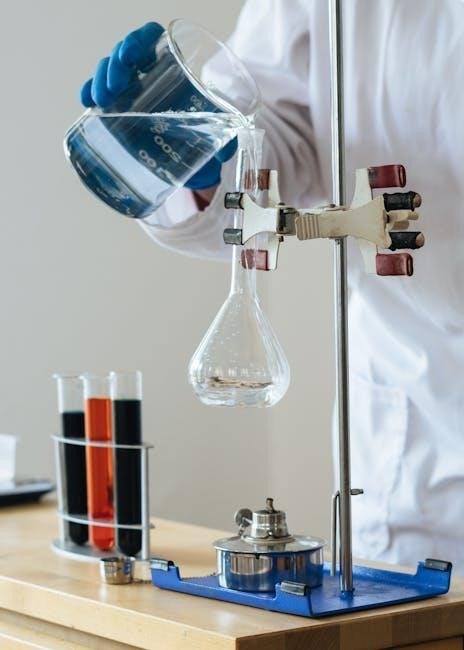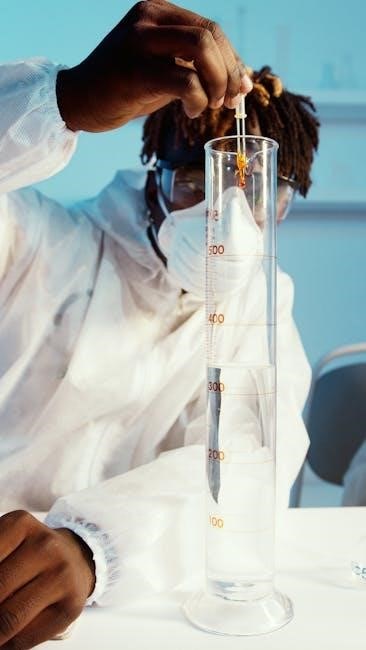The A113 chemical compound is a toxic substance with various industrial applications, including herbicides and pesticides production, affecting human health and environment significantly every day always․
Definition and Properties of A113
The definition of A113 is closely related to its chemical structure and properties, which are essential for understanding its behavior and uses․ A113, also known as 2,3,7,8-Tetrachlorodibenzo-p-dioxin, is a highly toxic and persistent organic pollutant․ Its properties include high stability and resistance to degradation, making it a persistent environmental contaminant․ The chemical formula of A113 is C12H4Cl4O2, and it is a byproduct of various industrial processes․ Understanding the properties of A113 is crucial for predicting its behavior in different environments and applications․ The definition and properties of A113 are critical for assessing its potential risks and benefits, and for developing strategies for its safe handling and disposal․ A113’s properties make it a significant concern for human health and the environment, and its definition is essential for understanding its role in various industrial and commercial contexts․
Chemical Structure and Formula
A113’s formula is C12H4Cl4O2, indicating a complex molecular structure always present․
Gibberellin A113 Chemical Formula
The Gibberellin A113 chemical formula is C20H26O5, which is a key piece of information for understanding its properties and behavior․ This formula indicates that the compound is composed of carbon, hydrogen, and oxygen atoms, and its molecular structure is complex․ The chemical formula is essential for identifying the compound and distinguishing it from other similar substances․ In the context of industrial and commercial applications, knowing the chemical formula of Gibberellin A113 is crucial for predicting its reactivity and interactions with other substances․ The formula C20H26O5 is a unique identifier for this compound, and it is used in various scientific and technical contexts to refer to Gibberellin A113․ By understanding the chemical formula, researchers and manufacturers can develop new uses and applications for this compound, and optimize its production and handling processes․ This information is widely available in scientific literature and online databases․

Industrial and Commercial Uses of A113
A113 is used in various industrial processes, including herbicides and pesticides production, affecting human health and environment significantly always with new applications emerging slowly․
Applications of A113 in Various Sectors
The applications of A113 are diverse and widespread, with uses in agriculture, pharmaceuticals, and manufacturing․ In agriculture, A113 is used as a herbicide and pesticide, helping to increase crop yields and reduce pest infestations․ In the pharmaceutical industry, A113 is used as an intermediate in the production of certain medications․ Additionally, A113 is used in the manufacture of various industrial chemicals, such as dioxins and furans․ The use of A113 in these sectors has raised concerns about its potential impact on human health and the environment․ As a result, regulatory agencies have established guidelines and regulations for the safe handling and disposal of A113․ Overall, the applications of A113 in various sectors are complex and multifaceted, requiring careful consideration of its potential benefits and risks․ A113 is an important chemical compound with a range of uses and applications․
Physical and Chemical Properties of A113
A113 has distinct physical and chemical properties affecting its behavior and uses in different industrial contexts every day always with specific characteristics․
Adrenochrome Chemical Properties
Adrenochrome is an unstable chemical compound with the chemical formula C9H9NO3, formed by the oxidation of epinephrine․ Its chemical properties include a violet color and a tendency to degrade quickly․ The compound has been linked to various health issues, including schizophrenia and other immunological disorders․ Understanding Adrenochrome’s chemical properties is essential for predicting its behavior and potential uses in different contexts․ Adrenochrome’s properties also make it a subject of interest in various fields, including medicine and chemistry․ With its unique characteristics, Adrenochrome continues to be a topic of research and study, aiming to uncover its full potential and implications for human health and the environment․ Its chemical properties play a crucial role in determining its applications and safety precautions, making it a compound of significant interest and importance in the scientific community always and every day․

Biological Activities and Safety Information
A113 poses significant health risks, including cancer and reproductive issues, requiring proper handling and safety precautions always and every day in various contexts․
Health Risks Associated with A113
The health risks associated with A113 are a major concern, as it has been linked to various health problems, including cancer, reproductive issues, and immunological disorders․ Exposure to A113 can occur through inhalation, skin contact, or ingestion, and can have severe consequences․ The chemical has been shown to cause damage to the liver, kidneys, and other organs, and can also affect the immune system․ Furthermore, A113 has been linked to neurological disorders, such as schizophrenia, and has been implicated in the LSD counterculture movement․ It is essential to handle A113 with caution and follow proper safety protocols to minimize the risk of exposure and prevent adverse health effects․ Understanding the health risks associated with A113 is crucial for developing effective safety measures and protecting human health․ A113’s toxic properties make it a hazardous substance that requires careful handling․

Patents and Literature on A113
US9907800 patent and literature provide information on A113 chemical properties and applications always online․
Research and Development of A113
Research on A113 is ongoing to understand its properties and applications, with studies focusing on its chemical structure and potential uses in various industries․
The development of A113 is a complex process, involving the synthesis of the compound and testing its effects on different materials and organisms․
Scientists use various methods to analyze A113, including spectroscopy and chromatography, to determine its composition and purity․
The research and development of A113 have led to the discovery of new applications for the compound, including its use in pharmaceuticals and agriculture․
Further research is needed to fully understand the potential of A113 and to develop new and innovative uses for the compound․
The study of A113 is a multidisciplinary field, involving chemists, biologists, and engineers working together to advance our knowledge of the compound․
New technologies and techniques are being developed to improve the production and use of A113․
Supplier Lists and Classification of A113
A113 suppliers provide classification information, including CAS numbers and chemical formulas, for safe handling and use of the compound always online․
Classification and Supplier Information
Classification of A113 is crucial for its safe handling and use, with suppliers providing necessary information, including CAS numbers and chemical formulas, to ensure compliance with regulations․
The compound is classified based on its chemical properties and potential hazards, with suppliers required to provide detailed information on its handling, storage, and disposal․
This information is essential for industries that use A113 in their products, as it helps them to ensure the safety of their workers and the environment․
Suppliers of A113 must also comply with relevant laws and regulations, including those related to transportation and exportation of the compound․
By providing accurate classification and supplier information, industries can minimize the risks associated with A113 and ensure its safe use․
This information is available online, making it easily accessible to industries and regulatory agencies․
Classification and supplier information is regularly updated to reflect changes in regulations and industry practices․

on A113 Chemical Uses
A113 chemical uses are diverse and significant in industrial contexts always requiring careful handling and regulation every day․
Importance of A113 in Industrial and Commercial Contexts
The importance of A113 in industrial and commercial contexts is significant, with various applications in herbicides and pesticides production, as well as other chemical manufacturing processes․ Understanding the properties and uses of A113 is crucial for industries that rely on this chemical compound․ The A113 chemical compound plays a vital role in the production of certain chemicals, and its impact on the environment and human health must be carefully considered․ In commercial contexts, A113 is used in various products, including agricultural chemicals and pharmaceuticals․ The demand for A113 is expected to continue growing, driven by the increasing need for effective and efficient chemical solutions in various industries․ As a result, the importance of A113 in industrial and commercial contexts will only continue to grow, with new applications and uses being developed over time․
